0. What is this post about?
The Indian Government announced the Production Linked Incentive (PLI) in 2020. The idea behind this is to make India self-sustained. Boosting manufacturing in key sectors within India is expected to reduce dependency on imports (import substitution). PLI is a financial incentive scheme, where applicable companies are rewarded on meeting production targets. This concept of financial support has been followed by multiple countries across the globe to boost industry sectors, such as the semiconductor industry. Post announcement of PLI schemes, both domestic and multinational companies welcomed the scheme. PLI scheme applicants were screened in FY 2021-22, and the final shortlist of companies was announced.
In this post, I will review the Pharma and Chemicals sector PLI schemes, and the final shortlisted companies. Finally, I will review the shortlisted companies, also listed on the Indian Stock Market, by the GEMS framework. GEMS framework of stock picking will provide a score to these companies, and rank them in terms of their fundamental strength and available valuation. With long term growth visibility, a certain government support, retail investors with mid to long term investment horizon can selectively pick stocks to get good returns. Investors can make low risk, above average returns by participating in the government driven economy growth.
1. What is the PLI Scheme?
Production Linked Scheme (PLI) is a revenue target based financial incentive scheme run by the Indian government. The intent is (a) Boost development in certain lagging sectors. (b) Encourage Make-In-India, which in turn will create jobs, and pave the path for future development and self-reliance of the country – India.
Indian and foreign companies can apply for the PLI incentive scheme, with the condition that the manufacturing should be done in India. The Indian government also benefits in the long run. The government benefits from increase in corporate taxes, exports taxes, income tax from newly salaried employees. The companies benefit from financial incentives from the government. It is a win-win situation.
Similar incentive schemes have been earlier adopted by different countries across the world. For a more detailed understanding of the PLI scheme, you can refer to the Part 1 post in the PLI series here.
2. Stock Picking Framework – G.E.M.S.
GEMS framework helps evaluate companies in terms of their (a) Growth (b) Efficient Operations (c) Management (d) Sale Price or valuation. A company is ranked higher if it is consistently growing, has healthy profit and operating margins, is run by a committed and transparent management, and is available at fair valuations. GEMS framework enables you to rank investable companies, helping you to choose the top stock picks for investment consideration. To know more on the GEMS framework, you can read Part 2 of PLI Blog series here.
3. Pharma PLI Scheme details
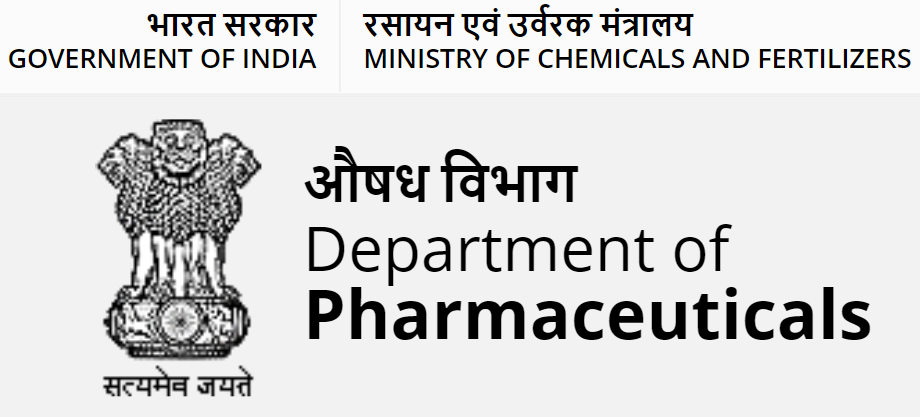
The Department of Pharmaceuticals, part of the Ministry of Chemicals and Fertilizers Government of India is the governing body behind the PLI scheme for the pharmaceutical sector. As per the PLI Scheme guidelines here, there are two objectives behind the pharma sector PLI scheme. First, is to boost domestic production across diversified pharmaceuticals in order to mitigate supply constraints. The second is to create global pharma champions out of India.
First objective is geared towards self-sustenance. The second objective is aspirational, to increase global contribution in the pharma sector coming out of India. A total sum of INR 15,000 Cr has been announced in this PLI scheme, which will last for 5 years, from FY 2023 to FY 2028.
The PLI scheme applicants are divided into three categories. The inferred reason behind this is to categorise pharma companies with large manufacturing capabilities, from mid and small ones. Group A applicants have more than INR 5000 Crore of annual manufacturing revenue. Group B applicants have between INR 500 Cr to INR 5000 Cr of annual manufacturing revenues. Group C has less than INR 500 Cr annual manufacturing revenue.
The pharma PLI scheme will reward shortlisted companies to the tune of 10% of the revenue generated above the cutoff threshold. Example: If the cutoff threshold of revenue is INR 60 Cr. And annual revenue achieved by the shortlisted company is INR 100 Cr. Then this company will get 10% of incremental revenue generated, which is INR 100-60 Cr = INR 40 Cr. Hence, this company will get 10% of INR 40 Cr, or INR 4Cr as PLI incentive for that year. There is an upper cap on the maximum incentive a company can get. This is done in order to restrict the majority of incentives being doled out to 1-2 companies.
Pharma PLI scheme received mixed response from the Indian pharma industry leaders. On one hand, many appreciated the first of its kind incentive scheme to boost domestic drug manufacturing. However, some pharma leaders such as Biocon, requested modification in the PLI scheme to make it more research based (article link here). Current PLI scheme uses generic drug filings to the US FDA, also known as ANDA. Using ANDAs as base for the PLI scheme will not boost innovation in the pharma sector in India. True innovation will come if the government supports risk capital for research in forward looking sectors such as biosimilars, gene therapies etc. It remains to be seen how the Department of Pharmaceutical responds to these requests. However, even if the department considers this request, it is unlikely that the current PLI scheme will be modified in the short term.
4. Pharma Stock Picks based on GEMS Framework
In this section, we will apply the GEMS framework discussed in section 2 to rank the companies shortlisted for the pharma PLI scheme. The idea is to filter these companies, and find ones with good fundamentals, fair valuation, which can be considered for investment.
Of the 55 companies shortlisted under Pharma PLI scheme, 19 companies are listed on the stock market. I will now apply the GEMS framework to these 19 companies, and provide scoring to them. Refer Appendix 1 for list of the 55 companies shortlisted in the pharma PLI scheme. I will be using screener.in for GEMS framework analysis.
This analysis is done in November 2022. If you are reading this post in a later month, you may want to redo this analysis for the current month. I have used screener.in to do the GEMS framework scoring. This site is free to use. You can feel free to use screener.in, or any other Indian stock screener you prefer/like.
4.1 G of GEMS – Growth

A good company shows consistency – consistency in growing its revenue (top line) and profits (bottom line). To ensure consistency, we will look at the historical 5 years CAGR (Cumulative Accumulated Growth Rate) in revenue and profit growth of the listed companies. Even though historical performance is not an indicator of future performance, it does give us a comfort in evaluating growth in a company.
Scoring based on Growth:
If either Revenue OR Profit CAGR is negative, then the score is 0.
If both Revenue AND Profit CAGR is between 0 to 10%, then the score is 1.
If one of Revenue OR Profit CAGR is between 0 to 10%, and another is > 10%, then the score is 2.
If both Revenue AND Profit CAGR is > 10%, then the score is 3.
Scoring based on historical growth for listed pharma companies is below.
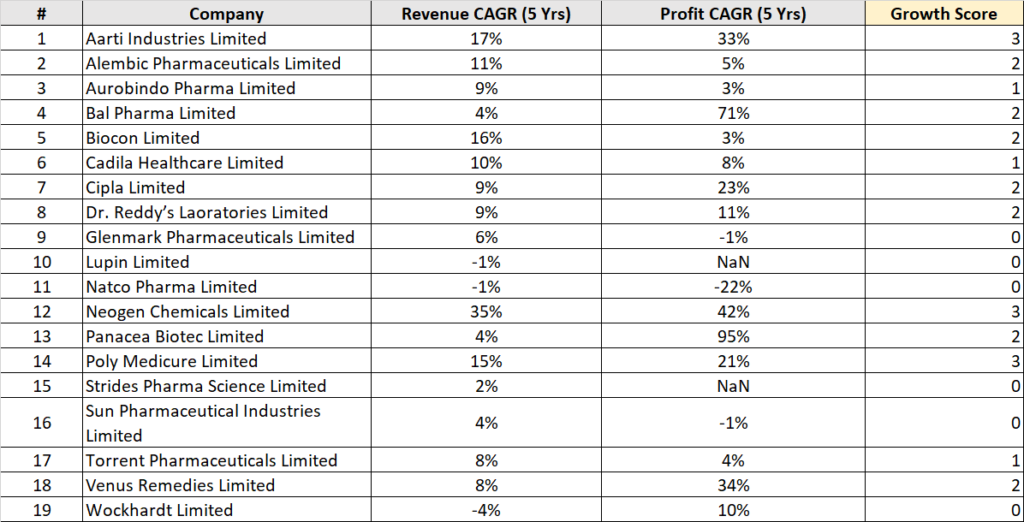
We see that big pharma companies have grown slowly, such as Dr Reddys or Sun Pharma. On the other hand smaller companies such as Neogen Chemicals, Poly Medicure have grown at a faster rate. Some pharma companies have shown degrowth over the past 5 years, hence they have received zero score.
4.2 E of GEMS – Efficient Operations
A company which is well run has higher margins than its peers (operating margin), and higher ROCE (Return on Capital Employed). High Operating Margin (OPM) indicates economies of scale, or technical advancement causing margins to be high or improve vs other peers. High ROCE indicates that every penny deployed generates good returns. Companies with good capital deployment strategy have higher ROCE. We will look at historical 5 yr average OPM, and 5 yr average ROCE to compare pharma companies.
Scoring based on Efficient Operations:
If either OPM OR ROCE is negative, then the score is 0.
If both OPM AND ROCE is between 0% and 10%, then the score is 1.
If one of OPM or ROCE is between 0% and 10%, AND the other one is > 10%, then the score is 2.
If both OPM AND ROCE are > 10%, but less than 15%, then the score is 3.
If both OPM and ROCE > 15%, then the score is 4.
Scoring based on historical operating margin and ROCE for listed pharma companies is below.

We see many pharma companies getting scores of 3 or 4, with high operating margins and return on capital employed. This is common in pharma companies, which generally enjoy high margins and ROCE.
Lets go to the next scoring framework to gauge good management in these companies.
4.3 M of GEMS – Management

To evaluate Management of a company, we will look at Promoter Holding%, Change in Promoter Holding%, and Pledge %. High promoter holding, and increase in promoter holding indicates that the management have skin in the game. This is considered good. Pledge % should be as low as possible, preferably 0%. A promoter who has to pledge his company shares in order to raise capital is not a good sign. A good promoter should rather raise capital via debt or PE investment.
Scoring is done as below:
If pledge % is more than 20%, then score is 0.
If promoter share < 40%, and change in promoter holding < 0%, then score is 0.
If promoter share < 40%, then score is 1.
If promoter share > 40% AND change in promoter holding < 0%, then score is 1.
If promoter share > 40%, pledge% > 0%, then score is 1.
If promoter share > 40%, change in promoter holding >= 0%< then score is 2.
If promoter share > 60%, pledge% = 0%, then score is 3.
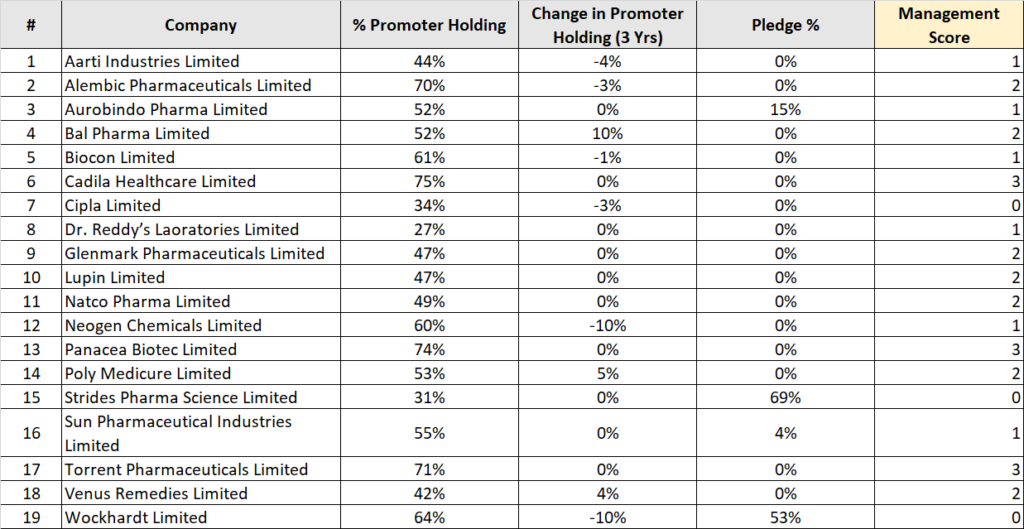
You should note that management quality is difficult to quantify. Metrics used in this section are indicative of dedicated management, who show skin in the game by having high promoter shareholding, and less pledged shares. You can do additional research if there have been any fraud cases against the company’s promoters or management before investing. This will additionally help you remove companies with ongoing or past fraud cases against their promoters/top management.
4.4 S of GEMS – Sale Price

To determine if a stock is available at fair valuation, we will look at: (a) Current PE vs 5 yr Median PE – Current PE less than 5 Yr Median PE indicates sale price, and vice versa. (b) Current Market Price (CMP) vs 200 DMA (200 day average price): CMP less than 200 DMA indicates sale price, and vice versa.
Scoring is done as below:
If PE is negative, then the score is 0.
If PE > 5 Yr Median PE, AND CMP > 200 DMA, then the score is 0.
If PE < 5 Yr Median PE, AND CMP > 200 DMA, then the score is 1.
If PE > 5 Yr Median PE, AND CMP < 200 DMA, then the score is 1.
If PE < 5 Yr Median PE, AND CMP < 200 DMA, then the score is 2.
The final scoring is as below.
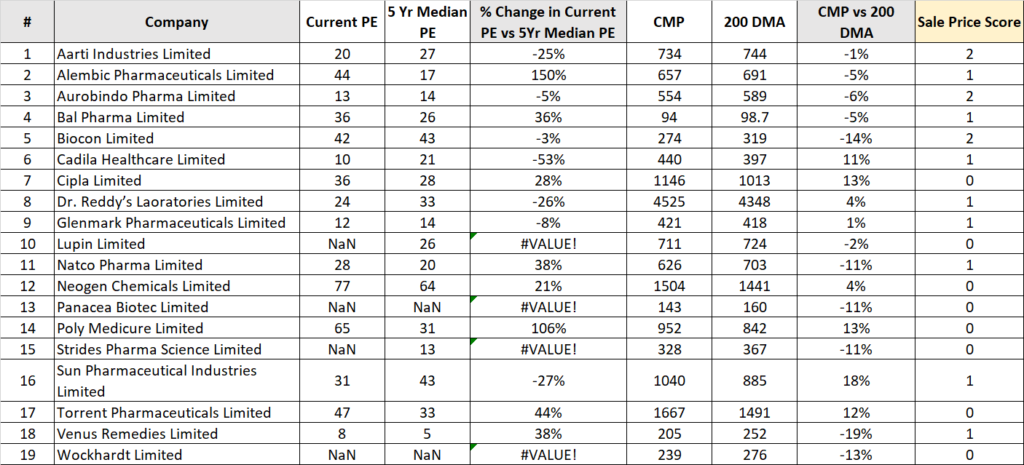
Now, let us combine all the scores to get the final GEMS scores for these pharma companies.
4.5 Final GEMS score
Combine Growth Score, Efficient Operations score, Management Score, and Sale Price score, we get the final GEMS score for these companies. Below table shows the GEMS score, with companies arranged in descending order of final scores.
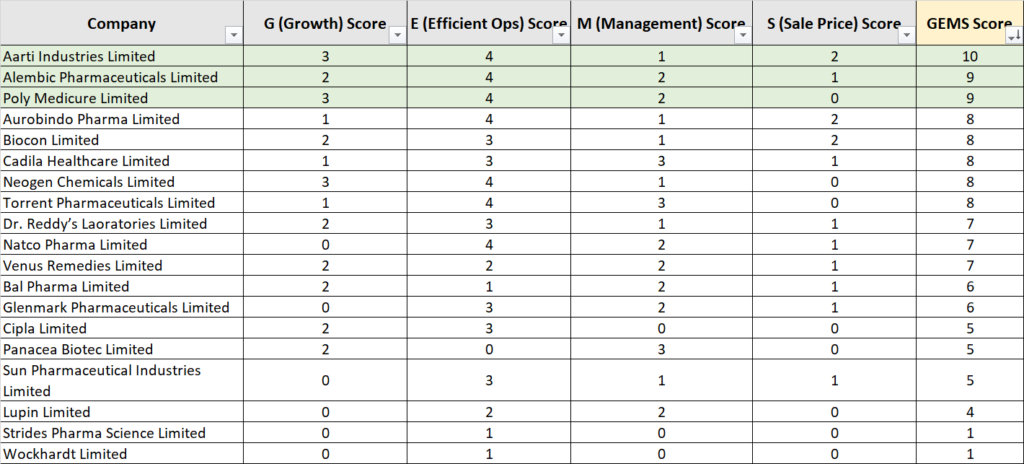
The top 3 pharma companies based on GEMS framework, which will also benefit from PLI scheme are:
GEM Stock 1 – Aarti Industries

Aarti industries is a mid-cap Pharma and Specialty chemicals company. It has a mix of domestic and international clients. It is a leader in benzene derivatives, and xanthine derivatives used in pharma and food industry. Its clients are diversified across Pharma, Paints, Agro, and Polymer industry sectors.
GEM Stock 2 – Alembic Pharmaceuticals

Alembic Pharmaceuticals is a mid-cap Pharma stock, focused on the branded generics market. Its 52% revenue comes from the US generics market, where it is facing increasingly stiff competition. The company is expanding in the domestic Indian market, in branded pharma market, and API business.
The company is spending heavily on R & D. Its operating margins have halved from 25% average in the past 5 years, to 13% in FY 22. However, margins are expected to pick up. Currently in Nov ’22 this company offers a good risk to reward ratio, and can be considered for investment.
GEM Stock 3 – Poly Medicure

Poly Medicure is a leading Indian manufacturer and exporter of medical devices. Poly Medicure is one of only five companies among 55 companies selected for the PLI Pharma scheme, for IVD, or In Vitro Diagnostics.
IVD is a diagnostic product, including reagent, instruments, and software for diagnosis of disease. IVD is used for collection and inspection of specimens from the human body. Poly Medicure has invested in end to end IVD product development, from apparatus, reagents, calibrators, software etc (refer company presentation slide 15 here).
The company has shown strong growth in the past 5 years, while consistently maintaining operating margins above 20%. Even though this company is currently slightly over valued as compared to its historical valuations, retail investors can consider accumulating this stock gem on price dips.
5. Chemical PLI Scheme Details
On first read, one might confuse Chemical PLI scheme with API manufacturers. API (Active Pharmaceutical Ingredient) is a key component of any drug. However, the Chemical PLI scheme is not related to API manufacturers. It is for Chemistry Cell – battery manufacturing. This will benefit the Electric Vehicle sector in India. The vision of the Indian government is to make India a global powerhouse in terms of battery manufacturing and energy storage. The incentive earmarked for this scheme is INR 18K Crore.

This scheme is governed by the Ministry of Heavy Industries of India (site link here). As of July 2022, three companies have been shortlisted under this scheme. These are Reliance New Energy Limited, Ola Electric Mobility, Pvt Ltd, and Rajesh Exports Ltd (press release here). Reliance New Energy Ltd is not separately listed on the stock market. One can invest in Reliance Industries, the parent and holding company for Reliance New Energy.
Ola Electric Mobility Pvt Ltd also is not yet listed on the stock market as of Nov 2022. Rakesh Exports Ltd is listed on the stock market. However, Rajesh Exports’ main business is in manufacturing of gold and gold products. Its entry into the energy/chemicals business is surprising. It is yet to be seen if Rajesh Exports will be able to perform well in the batteries sector. As an investor, if I were to consider investing into Rajesh Exports Ltd stock, I would value its gold business, as that is the core business of the company.
Electric vehicle space is the future, and will replace/substitute oil, diesel, and CNG based mobility. This story will play out over the next decade. However, I do not know yet which company will win in this space. In the battery sector, we have other larger established players such as Amara Raja Batteries. Purely based on the PLI scheme, I might consider investing in Reliance Energy which is a behemoth of a company, and sees the battery segment as a key part of its new energy business front.
6. Parting Thoughts
PLI scheme is a first of its kind in India. It may not well be the last. When the national government decides to support an industry sector, and puts money in form of incentive behind their vision, it is next to certain that this industry sector will benefit. Retail investors should make the most of such schemes, and participate in the growth journey of positively impacted stocks. In some indirect ways, as a tax paying citizen, it is your money which is being used to fund such a scheme. So why not utilise this opportunity to invest and make positive returns in the next 405 years.
Investors should note that returns from investing in companies shortlisted in PLI schemes will come in the long run, in a 3-5 years timeline. Currently, in 2022, shortlisted companies are in the investment phase. The manufacturing and scheme kick-in will happen FY 2023 onwards. As revenue of the companies grow, the earnings will grow, and the stock price of the company will catch up. Stock price increase will make positive returns for your investments. A good win-win situation for companies, government, and us retail investors.
Which pharma company shortlisted in the pharma PLI scheme is your favorite?
Do comment below.
Happy investing !
Disclaimer: Do note that this post is not investment advice. Please consult your investment advisor, or do your own research before investing.
Appendix 1: List of Companies shortlisted for Pharma PLI scheme
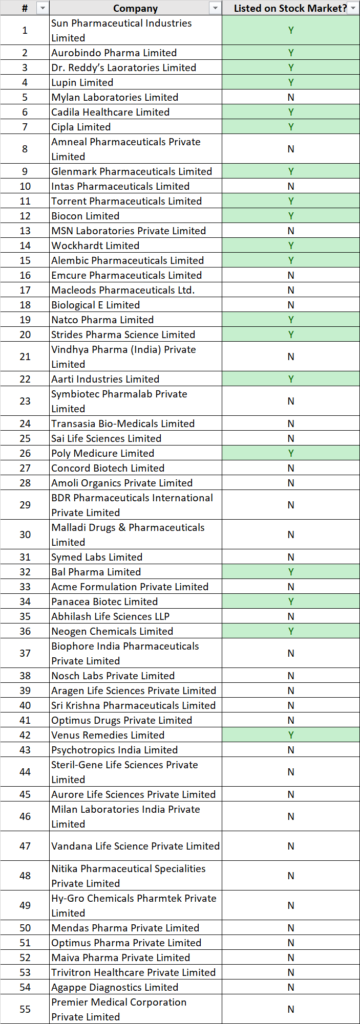

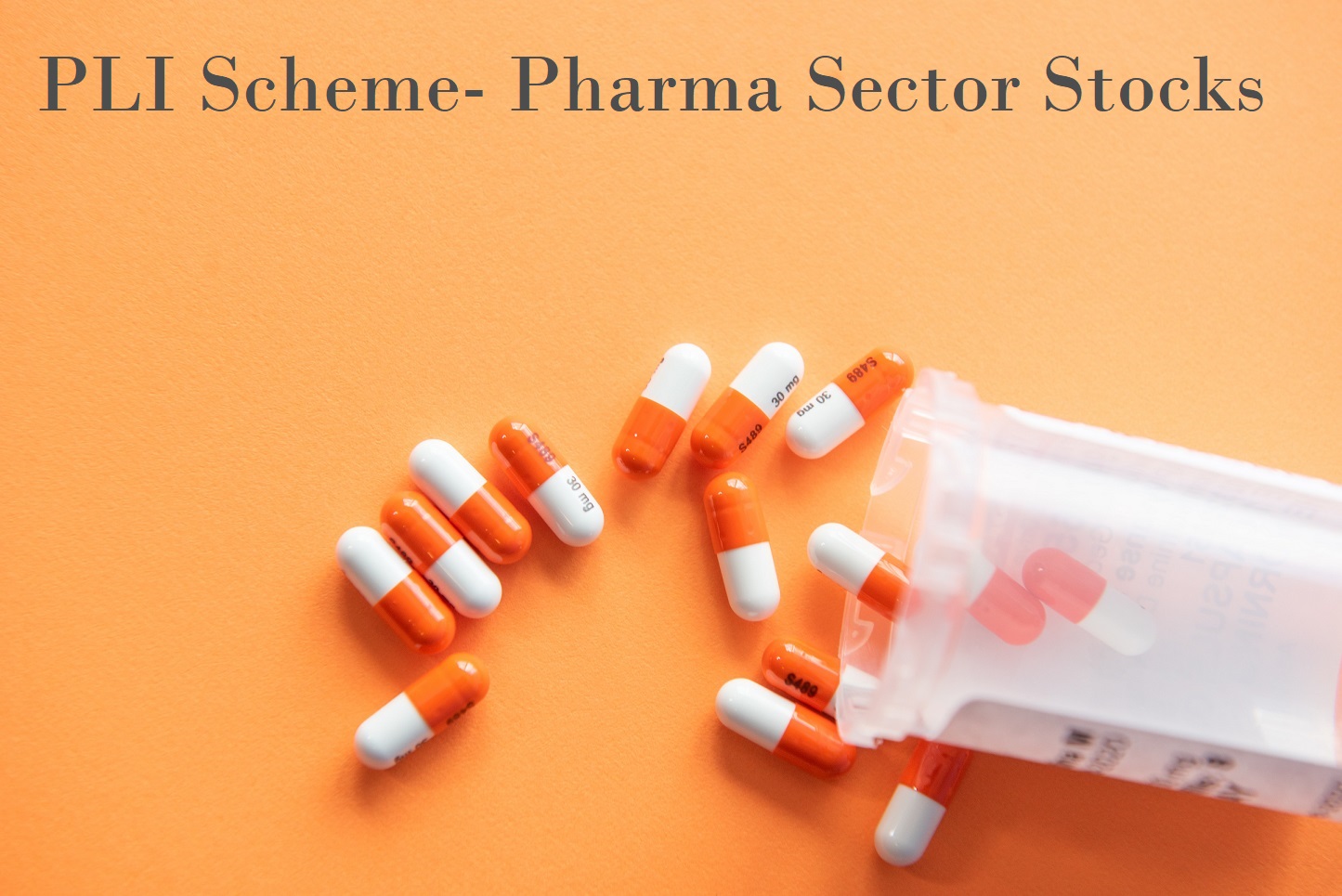



Pingback: Buy the Dip Vs Avoid Catching a Falling Knife Investment Approach - Mayank Dwivedi
Pingback: Picking Stock Gems based on PLI Scheme | PLI Scheme Stocks